Books by Francismar Alex Lopes de Carvalho
Leiden: BRILL, 2022
Established in 1638 in a vast Amazonian territory that today encompasses border areas of Ecuador,... more Established in 1638 in a vast Amazonian territory that today encompasses border areas of Ecuador, Peru, Colombia, and Brazil, the missions of Maynas were one of the Society of Jesus' main enterprises in Spanish America. Jesuit writings provide a unique insight into the seventeenth-and eighteenthcentury encounters between Europeans and indigenous peoples. In effect, they shed light on how native Amazonians appropriated elements of Christian religiosity and Iberian urban culture. This book is not only about how indigenous populations experienced life in missions. It is above all a study of how natives actively engaged with the practices and ideas of settlement and religiosity transmitted by the Jesuits.

London: Palgrave Macmillan, 2022
This book examines the efforts of Spaniards and Portuguese to attract Native peoples and other se... more This book examines the efforts of Spaniards and Portuguese to attract Native peoples and other settlers to the villages, missions, and fortifications they installed in a disputed area between present-day Brazil, Bolivia, and Paraguay. The first part examines how autonomous Native peoples and those who lived in the Jesuit missions responded to the Indigenous policies the Iberian crowns initiated following the 1768 expulsion of the Society of Jesus. The second part examines military recruitment and supply circuits, showing how the political centers' strategy of transferring part of the costs and delegating responsibilities to local sectors shaped interactions between officers, soldiers, Natives, and other inhabitants. Moving beyond national approaches, the book shows how both Iberian empires influenced each other and the lives of the diverse peoples who inhabited the border regions.
Articles by Francismar Alex Lopes de Carvalho

The Americas, 80(3), 433-469, 2023., 2023
In the Spanish monarchy, corporations, religious orders, and other petitioners kept procurators i... more In the Spanish monarchy, corporations, religious orders, and other petitioners kept procurators in Madrid to lobby the royal councils on their behalf. Drawing on an efficient network of information, the Madrid-based Jesuit procurators were known for their insistence on solving the financial and personnel needs of several missions throughout the New World. This article analyzes a series of petitions composed by Antonio Ruiz de Montoya in the late 1630s on behalf of Jesuit missions in Paraguay. These missions had been harassed by Portuguese slavers, who captured tens of thousands of natives in this region. Ruiz de Montoya's petitions reveal that the Jesuits’ lobbying actions had a much greater impact than has been assumed. Far from confining themselves to asking for material and human resources for the missions, the Jesuits proposed that the Spanish crown make a large-scale intervention in the administration of Portuguese domains in the South Atlantic, a program that Madrid would have implemented were it not for Portuguese independence in 1640.

Ethnohistory 70 (1), 65–93, 2023
For decades, historiography on the Iberian empires has suggested that peace treaties between Euro... more For decades, historiography on the Iberian empires has suggested that peace treaties between Europeans and autonomous Native groups incorporated both Indigenous "nations," understood as cohesive units, and Native lands into the monarchy. Drawing on extensive archival evidence and recent borderlands scholarship, this article suggests that written agreements had a limited impact on interethnic frontier relations. First, because informal relations shaped by Indigenous patterns of diplomacy were far more important to the success of alliances. Second, because alliances were often made with autonomous tolderías, not with homogeneous "nations." And third, because Natives by no means identified their ethnic territories with Crown possessions, but continued to independently exploit Iberian rivalries in order to achieve more favorable conditions for themselves. This article focuses on the frontier between the Spanish province of Paraguay and the Portuguese captaincy of Mato Grosso.
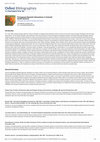
Oxford Bibliographies in Latin American Studies, 2022
On 7 June 1494, Portugal and Spain signed the Treaty of Tordesillas, an agreement that divided th... more On 7 June 1494, Portugal and Spain signed the Treaty of Tordesillas, an agreement that divided the world by a line that cut from pole to pole and began 370 leagues west of the Cape Verde Islands. This line allowed Portugal to claim possession of the coast of Brazil but it was quickly ignored by westward exploration movements that brought Portuguese, Spanish, Indigenous people, and people of African descent into contact and provided grounds for numerous conflicts in the following centuries. Even with the diplomatic efforts that led to the treaties of Madrid (1750) and San Ildefonso (1777), the boundaries between Iberian domains in South America remained porous and uncertain. A quick look at a map of South America allows us to see that from the Río de la Plata to Amazonia and from Paraguay to Guayana, the possibilities for interaction between Natives, Iberians, and people of African origins were numerous; if we include the major ports of South America (Buenos Aires, Callao, Guayaquil, Cartagena, Recife, Salvador, Rio de Janeiro) and the proximity of Angola, these possibilities, including legal and illegal trade, multiplied exponentially. We must not forget that Portugal and Spain did not remain opposite political entities during the early modern period. There were periods of political and diplomatic rapprochement and, of course, the years between 1580 and 1640, when Portugal was united with the Spanish empire in the so-called Iberian Union. Moreover, what it meant to be Portuguese—and what it meant to be Spanish—were also being defined. For these reasons, it is not surprising that historians have been concerned with the interactions between the Portuguese and Spanish in South America for a long time. Until the mid-20th-century, topics such as diplomacy, territorial demarcation, and military conflicts received more attention. In recent decades, however, historians have been more attentive to the interactions between individuals and groups “on the ground,” with special emphasis on the agency of Indigenous peoples, smugglers, merchants, slave traders, enslaved people of African origin, cartographers, and others. Modern historians have sought to understand how these frontier interactions influenced the formation of individuals’ identities, the personal and commercial networks they wove, and the knowledge about the environment they provided. Another topic of great importance concerns how Native peoples maintained their autonomy despite the expansion of the Iberian empires, especially during the eighteenth century. This article presents some of the most prominent works on each of these themes and resources for scholars to find relevant materials. Some studies are listed by theme (cartography, demarcation, diplomacy, etc.), while others are listed according to geographical subdivisions. Naturally, the studies that appear in thematic topics could also fit within regional categories, but we prefer to separate them by their relevance to the specific theme. In the regional topics, the “on the ground” interactions of Indigenous people with people of African, Spanish, and Portuguese origin stand out. Finally, it is important to note that in this essay, we concentrate on the colonial period, from the sixteenth to the eighteenth centuries, and that we do not present references pertaining to the independence processes of South American countries, as we believe that this topic demands a separate essay.

Hispanic American Historical Review 102 (2), 191–221, 2022
After signing the 1777 Treaty of San Ildefonso, Spain and Portugal sent joint expeditions to dema... more After signing the 1777 Treaty of San Ildefonso, Spain and Portugal sent joint expeditions to demarcate their South American borders, as they had done a quarter century earlier. Focusing on the activities of Spanish commissioner Francisco Requena in western Amazonia in the 1780s and 1790s, this article shows that such efforts were not limited to confirming in loco the lines drawn in European courts. I demonstrate how Indigenous populations played on Iberian rivalries to maintain their autonomy and negotiate their resettlement. The very interactions between commissioners and Indigenous peoples intensified the porosity of border spaces. Because commissioners believed that sovereignty was defined through monarchical loyalty rather than simply lines on a map, they contributed to the movement of people and goods across the dividing line that they intended to create, making the border even more permeable to Indigenous claims to territoriality and cross-border interactions.

Colonial Latin American Review, 29 (1), 47-72, 2020
This article delves into a collection of memoriales dispatched to the Council of the Indies by se... more This article delves into a collection of memoriales dispatched to the Council of the Indies by settlers and officials residing in the viceroyalty of Peru during the early seventeenth century. These texts illuminated issues related to the recruitment of laborers for Peruvian silver mines and offered potential solutions. Two recurrent themes stood out among the proposals: first, the prospect of uncovering fresh mineral deposits in the Amazonian lowlands, and second, the resettlement of indigenous laborers in the vicinity of Potosí. Informed by the authors' desire to receive accolades and rewards for their loyalty to the Spanish Crown, these undertakings were viewed with circumspection in Madrid. As part of the arbitrista literature, memoriales were an instrument of political communication between subjects and the Spanish monarchy. This article argues that the central power’s information accumulation served not only to guide administrative decisions, but also to stimulate mutual vigilance among subjects by providing information on the honor and quality of each one of them.

Rivers and Shores: ‘Fluviality’ and the Occupation of Colonial Amazonia, edited by Rafael Chambouleyron and Luís Costa e Sousa, 133-162. Peterborough, Ontario, Canada: Baywolf Press, 2019
From the late seventeenth century through the eighteenth century, the arrival of missionaries and... more From the late seventeenth century through the eighteenth century, the arrival of missionaries and colonists in Iberian western Amazonia instigated disputes over territorial claims that greatly impacted indigenous populations. This article delves into three particular issues. Firstly, it examines the response of the native peoples to conflicts between Iberian clergy who sought exclusive rights to evangelize in the region, and whether or not the indigenous believed that missions could offer protection from slaving expeditions. Secondly, it investigates the justifications put forth by the clergy to claim exclusive rights to a particular area and the loyalty of the native population. How did the clergy describe the work of their rivals? What were the similarities and differences in their methods of missionary work? Finally, this work explores the nature of the relationships among missionaries themselves. Did loyalty to the Crown outweigh allegiance to one's religious order? And what was the nature of the relationship between clergy and members of slaving expeditions? Through an analysis of the reciprocal influence of Iberian religious orders in Amazonia and the reactions of the indigenous peoples, this study reveals that the conflict over religious conversion was inexorably linked to the contest to integrate the natives as subjects into either the Portuguese or Spanish Iberian monarchies. The formation of the boundaries between the jurisdictions of religious orders, which could also represent the boundaries between the Iberian empires, was largely determined by the twists and turns of the debate over the conversion and loyalty of the Natives, as well as their responses to the pressures of colonialism.
Books in Portuguese by Francismar Alex Lopes de Carvalho
Livro baseado na minha tese de doutoramento defendida na Universidade de São Paulo, em 15 de març... more Livro baseado na minha tese de doutoramento defendida na Universidade de São Paulo, em 15 de março de 2012.

São Paulo: Unifesp, 2019
In contemporary times, there lies a great significance in reexamining the theme of the "monções" ... more In contemporary times, there lies a great significance in reexamining the theme of the "monções" - a term that evokes the image of flotillas of canoes, once utilized by adventurous travelers traversing the river path connecting São Paulo and Cuiabá, during a period spanning from the 1720s to the mid-19th century. While scholars of the early modern period have been preoccupied with the frontier regions of colonial empires for several decades, the present-day has brought forth a set of sensitive issues that historians must contend with, such as the permeability of state borders and questions of ethnic, cultural, and national identity. This scenario necessitates a fresh perspective on the past. A product of meticulous documentary research, this book invites reflection on the obstacles encountered on communication routes in colonial South America, the adaptation of the indigenous legacy of knowledge and practices essential for navigating the remote hinterlands, and the intricate network of alliances and conflicts between the riverside populations and the colonizers. Consequently, this work represents an exceptional contribution to the scholarship on the Iberian expansion throughout the lowlands of South America. = This book was originally published in Portuguese.

São Paulo: Alameda, 2014
This book offers an innovative examination of a longstanding issue, namely, the territorial dispu... more This book offers an innovative examination of a longstanding issue, namely, the territorial dispute between the Spanish and Portuguese empires. The dispute was aggravated by the 1750 Treaty of Madrid's ambiguous provisions concerning the regions bordering the provinces of Mojos, Chiquitos, Paraguay, and the captaincy of Mato Grosso. Prior scholarship has established that both empires constructed fortifications and settlements, attracted indigenous populations to the peripheries, and established settlers in the disputed areas. However, this study's original contribution is to emphasize that governance of the frontier was achieved through the delegation of responsibilities and transfer of costs to settlers and indigenous peoples. This book challenges prevailing historiographical notions of the Crown's imposition of its will on settlers, demonstrating instead an asymmetric negotiation between the two parties. Governance of the frontier was achieved through the promise, or concession, of unequal privileges and benefits. In the pursuit of loyalty from frontier populations, the monarchy that had the resources and skilled officials capable of mobilizing local initiatives was better equipped to consolidate its territorial sovereignty. = This book was originally published in Portuguese.
Articles in Portuguese and Spanish by Francismar Alex Lopes de Carvalho
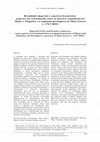
Antíteses, 2011
Spaniards and Portuguese had applied different policies concerning the contraband in South Americ... more Spaniards and Portuguese had applied different policies concerning the contraband in South American frontiers. While Spanish Empire forbade the commerce with foreigners, the Portuguese Crown secretly stimulated the contraband at Colônia do Sacramento and Mato Grosso. During the second half of eighteenth century, contraband became intensely practiced by merchants, missionaries, military and even governors in the valley of the Guaporé River. The missions of Mojos and Chiquitos consolidated the production of cattle, tallow, mules, cocoa, cotton and sugar, but irregular supply of European goods encouraged missionaries and Spanish merchants to seek alternative suppliers. At the same time, in Portuguese capitania of Mato Grosso, orders of the central power, availability of gold and demand in fort Príncipe da Beira propitiated convergence with Spanish vassals' aspirations. This paper analyses the impacts of contraband among Spanish and Portuguese administrative institutions, merchants and indigenous peoples in the contested frontier of Mojos, Chiquitos and Mato Grosso provinces. It focuses on the period after the expulsion of Jesuits, when contraband prospered, and the late Spanish reformist governors.
Fênix (UFU. Online) , v. 3, p. 1-20, 2006, 2006
The Mbayá-Guaykuru held a pivotal role in the colonial-era conflicts over dominance in the Paragu... more The Mbayá-Guaykuru held a pivotal role in the colonial-era conflicts over dominance in the Paraguay River valley. This study delves into the group's socio-political development, focusing on their interactions with other Chaqueño indigenous groups and the Spanish and Portuguese settlers. More precisely, it aims to understand how the Mbayá-Guaykuru successfully maintained their territorial acquisitions in the midst of colonial expansions during the 18th century.
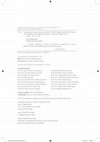
Trajetórias americanas: volume 1 (séculos XV-XIX), edited by Rafael Araujo et al., 89-124. Recife: Edupe, 2022
The significance of Jesuit priest José de Acosta's writings and actions for the conversion of ind... more The significance of Jesuit priest José de Acosta's writings and actions for the conversion of indigenous populations in the Americas cannot be overstated. Acosta's influence was felt as early as the late sixteenth century when his resettlement and catechetical policies were adopted by the Spanish Empire. His depictions of native cultures and analyses of conversion methods have continued to exert a profound impact to this day. This chapter delves into Acosta's position in the debates among religious and jurists in the sixteenth and seventeenth centuries about the most appropriate approach to evangelizing the indigenous peoples, highlighting his unique contributions in this field. Additionally, the chapter considers the challenges posed by the application of Acosta's proposals to the Jesuit missions established in the lowlands of South America.

História (São Paulo), 39, 1-36, 2020
During the sixteenth and seventeenth centuries, a vigorous discourse among Spanish clergymen, jur... more During the sixteenth and seventeenth centuries, a vigorous discourse among Spanish clergymen, jurists, and officials arose concerning the origins of indigenous peoples in the Americas. These literati interpreted the Old Testament in many different ways in order to explain how the natives came to the Americas. Fundamental questions they confronted included the identity of the Amerindians, their arrival in the Americas, and the rights of the Spaniards to claim sovereignty over their lands and peoples. This inquiry scrutinizes the distinctive stance of Miscelánea Antártica, written by Spanish clergyman Miguel Cabello Valboa in 1586, during this intense debate. Cabello Valboa’s manuscript was among the earliest books solely dedicated to this subject, and it possessed an originality that presented a positive outlook on indigenous peoples. Through his unconventional interpretation of the Bible, Cabello Valboa constructed a remarkably positive genealogy for the Amerindians, tracing their lineage back to Ophir and, by extension, Shem, Noah’s son. His favorable view of Andean cultures did not neglect the violence of the conquest, but emphasized mestizaje as a way of conciliation.

Revista de Indias, 78 (274), 687-733, 2018
During the mid-sixteenth century and the entirety of the seventeenth century, settlers and missio... more During the mid-sixteenth century and the entirety of the seventeenth century, settlers and missionaries devoted themselves tirelessly to explore the outskirts of Amazonia, located to the east of the Audiencia of Quito. This era of exploration was marked by the proliferation of diverse depictions of the native peoples. The Iberians grouped the indigenous communities into two distinct categories, namely those exhibiting a certain degree of "polity" (as perceived through Iberian eyes), and were consequently labeled as "friends." Conversely, other groups were typified as "barbarians," nomads, and even cannibals. A more profound analysis of these depictions reveals that they were in line with the settlers' and missionaries' specific objectives, which were to capture indigenous peoples for personal service and establish missions. = This article was originally written in Portuguese. For a more in-depth and up-to-date discussion, see my book Missionizing on the Edge.

Revista Complutense de Historia de América, 44, 111-138, 2018
This paper delves into the intricate methods that the Jesuits employed to procure the necessary r... more This paper delves into the intricate methods that the Jesuits employed to procure the necessary resources, both material and human, to sustain their missions in Spanish Amazonia. Specifically, the Maynas reductions, situated on the fringes of the jurisdiction of the Audiencia de Quito, were under Jesuit supervision between 1638 and 1767. While the Jesuits were unable to establish a self-sustaining production system in these missions, they relied on a combination of private donations, funds from neighboring Colegios, and remittances from the royal treasury, which were finally settled in 1716. This research endeavors to uncover the reasons why it took the Jesuits such a protracted time to receive long-term financial aid from the royal treasury, as well as the approaches they utilized to secure funding from the Council of the Indies for their initiatives in the Spanish Amazonian region. I argue that the success of recruitment and retention of missionary personnel was contingent upon the tension between local economic interests, the influence of Jesuit procurators on the Council of the Indies, and Spain's defensive tactics against the Portuguese territorial expansion. = This article was originally written in Spanish. For a more in-depth and up-to-date discussion, see my book Missionizing on the Edge.
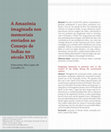
Revista Tempo (UFF), 23 (2), 205-238, 2017
During the seventeenth century, intrepid settlers and devoted missionaries embarked upon a rigoro... more During the seventeenth century, intrepid settlers and devoted missionaries embarked upon a rigorous exploration of the Amazonian lowlands, situated to the east of the Viceroyalty of Peru. Seeking recognition and acclaim for their past and future efforts on the frontier, they submitted petitions to the Council of the Indies. These missives not only chronicled the indigenous peoples and idyllic landscapes of the Amazonia, but also drew comparisons to legendary realms such as El Dorado and Paititi. In this article, I posit that these depictions should not be relegated to the realm of mythos, but rather viewed as strategic discursive devices employed in the negotiation of honors, awards, and privileges between local actors and the Spanish Crown. While these petitions did indeed provide the Council of the Indies with information regarding far-flung domains and the undertakings of settlers and missionaries residing therein, the depictions of the Amazonian peoples and landscapes were markedly influenced by the political objectives of the petitions. = This article was originally written in Portuguese.
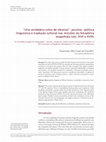
Revista História Unisinos, 21 (3), 392-410, 2017
The present study delves into the Jesuit linguistic policy in Spanish Amazonia in the seventeenth... more The present study delves into the Jesuit linguistic policy in Spanish Amazonia in the seventeenth and eighteenth centuries. By situating the Jesuit practices and perspectives on the translation of Catholic concepts within the wider context of the linguistic policy of the Spanish Empire, this article offers a nuanced understanding of their approach. Drawing on illustrations from vocabularies and catechisms that the Jesuits produced among Amazonian Indians, the study illuminates the main challenges and strategies adopted by the Jesuits. The article concludes by focusing on the issues related to the translation of Christian doctrinal terms into native languages, and offers insights into the indigenous interpretation and utilization of these concepts. = This article was originally written in Portuguese. For a more in-depth and up-to-date discussion, see my book Missionizing on the Edge.

Revista Anos 90, 23 (43), 321-366, 2016
The present study delves into the significance of missionary entradas within the Maynas region in... more The present study delves into the significance of missionary entradas within the Maynas region in relation to the diverse ethnic groups involved. The Maynas missions were established amidst the indigenous populations dwelling in the western fringes of the Amazonian region, particularly in the valleys of the Marañón, Napo, and Amazon rivers. Active in the region between 1638 and 1767, the Company of Jesus resorted to military expeditions known as "missionary entradas" to draw the Indians from the vicinity to dwell on reductions, either through force or persuasion. While this approach was a common practice in other areas of Jesuit activity, it gained unprecedented frequency in Maynas, with successive entradas aiming to expand and consolidate the territorial domain of the missionaries and fulfill the demands of indigenous groups in the face of increased interethnic rivalry. However, as the present work endeavors to demonstrate, the indigenous reality overshadowed the designs of the missionaries. The repeated entradas endeavored to accommodate groups that were not amenable to living together, leading to an excess in the number of reductions beyond the capacity of the Jesuits to attend to them. This recurrent process ultimately necessitated further missionary entradas to restore balance and homogeneity within the province. = This article was originally written in Spanish. For a more in-depth and up-to-date discussion, see my book Missionizing on the Edge.










Uploads
Books by Francismar Alex Lopes de Carvalho
Articles by Francismar Alex Lopes de Carvalho
Books in Portuguese by Francismar Alex Lopes de Carvalho
Articles in Portuguese and Spanish by Francismar Alex Lopes de Carvalho
El simposio busca reunir a investigadoras e investigadores del ámbito hispano y
lusoamericano que propongan miradas renovadas e investigaciones en curso sobre los
proyectos y experiencias religiosas, discursos y prácticas misioneras, que se desplegaron en las fronteras de colonización iberoamericanas, delimitadas desde la “Gran Chichimeca” del norte de México, pasando por los contextos andinos, la Amazonia, el Chaco, el interior del Brasil, hasta el sur de Chile y Patagonia, entre otras áreas. A lo largo del continente se articularon, de esta manera, una serie de regiones fronterizas, donde los agentes jesuitas, pero también franciscanos, mercedarios, capuchinos o carmelitas, entre otros, buscaron activar dispositivos de evangelización sobre indígenas no sometidos al control colonial. Espacios donde la autonomía indígena interactuaba con guerras de conquista o intercambio material, y donde los misioneros buscaron convertir a los llamados “indios de guerra” o “indios fronterizos”, generalmente calificados como “bárbaros”. Espectativas que muchas veces terminaron en fracasos, o en resultados de éxito modesto o de franca ambigüedad en sus pretensiones de ortodoxia. Esto último, debido a las negociaciones y adaptaciones que el contexto y la propia agencia indígena les impusieron. El simposio propuesto, por lo tanto, no solo busca incorporar ponencias sobre experiencias concretas de éxitos y fracasos misioneros, así como los proyectos, miradas y representaciones de las órdenes y agentes católicos sobre los contextos de aquellas “fronteras misionales”. También se destaca como un objetivo fundamental la incorporación de investigaciones que se centren en la experiencia y el protagonismo de los propios grupos indígenas en aquellas prácticas misioneras.